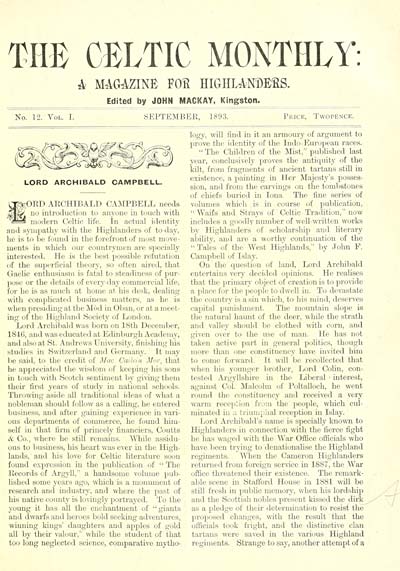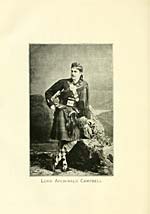Blair Collection > Celtic monthly > Volume 1, 1893
(209)
Download files
Complete book:
Individual page:
Thumbnail gallery: Grid view | List view

THE CELTIC MONTHLY:
A MAGAZINE FOft HIGHLANDERS.
No. 12. Vol. I.
Edited by JOHN MACKAY, Kingston.
SEPTEMBER, 1893.
Price, Twopence.
LORD ARCHIBALD CAMPBELL.
;;ORD ARCHIBALD CAMPBELL needs
no introduction to anyone in touch with
modern Celtic life. In actual identity
and sympathy with the Highlanders of today,
he is to be found in the forefront of most move-
ments in which our countrymen ai-e specially
interested. He is the best possible refutation
of the superficial theory, so often aired, that
Gaelic enthusiasm is fatal to steadiness of pur-
pose or the details of every-day commercial life,
for he is as much at home at his desk, dealing
with complicated business matters, as he is
when presiding at the Mod in Oban, or at a meet-
ing of the Highland Society of London.
L< nil Archil laid was born on 18th December,
1840, and was educated at Edinburgh Academy,
and also at St. Andrews University, finishing his
studies in Switzerland and Germany. It nun-
be said, to the credit of Mac Cailein Mor, that
he appreciated the wisdom of keeping his sons
in touch with Scotch sentiment by giving them
their first years of study hi national schools.
Throwing aside all traditional ideas of what a
nobleman should follow as a calling, he entered
business, and after gaining experience in vari-
ous departments of commerce, he found him-
self in that firm of princely financiers, Coutts
& Co., where he still remains. While assidu-
ous to business, his heart was ever in the High-
lands, and his love for Celtic literature soon
found expression in the publication of " The
Records of Argyll," a handsome volume pub-
lished some years ago, which is a monument of
research and industry, and where the past of
his native county is lovingly portrayed. To the
young it has all the enchantment of "giants
and dwarfs and heroes bold seeking adventures,
winning kings' daughters and apples of gold
all by their valour," while the student of that
too long neglected science, comparative mytho-
logy, will find in it an armoury of argument to
prove the identity of the Indo-European races.
•• The Chudren of the Mist," published last
year, conclusively proves the antiquity of the
kilt, from fragments of ancient tartans stul in
existence, a painting in Her Majesty's posses-
sion, and from the carvings on the tombstones
of chiefs buried in Iona The fine series of
volumes which is in course of publication,
"Waifs and Strays of Celtic Tradition," now
includes a goodly number of well-written works
by Highlanders of scholarship and literary
ability, and are a worthy continuation of the
" Tales of the West Highlands," by John F.
Campbell of Islay.
On the question of land, Lord Archibald
entertains very decided opinions. He realises
that the primary object of creation is to provide
a place for the people to dwell in. To devastate
the country is a sin which, to his mind, deserves
capital punishment. The mountain slope is
the natural haunt of the deer, while the strath
and valley should be clothed with corn, and
given over to the use of man. He has not
taken active part in general politics, though
more than one constituency have invited him
to come forward. It will be recollected that
when his younger brother, Lord Cohn, con-
tested Argyllshire in the Liberal - interest,
against Col. Malcolm of Poltalloch, he went
round the constituency and received a very
warm reception from the people, which cul-
minated in a triumphal reception in Islay.
Lord Archibald's name is specially known to
Highlanders in connection with the fierce fight
he has waged with the War Office officials who
have been trying to denationalise the Highland
regiments. When the Cameron Highlanders
returned from foreign service in 18S7, the War
office threatened their existence. The remark-
able scene in Stafford House in 1881 will be
still fresh in public memory, when his lordship
and the Scottish nobles present kissed the dirk
as a pledge of their determination to resist the
proposed changes, with the result that the
officials took fright, and the distinctive clan
tartans were saved in the various Highland
regiments. Strange to say, another attempt of a
A MAGAZINE FOft HIGHLANDERS.
No. 12. Vol. I.
Edited by JOHN MACKAY, Kingston.
SEPTEMBER, 1893.
Price, Twopence.
LORD ARCHIBALD CAMPBELL.
;;ORD ARCHIBALD CAMPBELL needs
no introduction to anyone in touch with
modern Celtic life. In actual identity
and sympathy with the Highlanders of today,
he is to be found in the forefront of most move-
ments in which our countrymen ai-e specially
interested. He is the best possible refutation
of the superficial theory, so often aired, that
Gaelic enthusiasm is fatal to steadiness of pur-
pose or the details of every-day commercial life,
for he is as much at home at his desk, dealing
with complicated business matters, as he is
when presiding at the Mod in Oban, or at a meet-
ing of the Highland Society of London.
L< nil Archil laid was born on 18th December,
1840, and was educated at Edinburgh Academy,
and also at St. Andrews University, finishing his
studies in Switzerland and Germany. It nun-
be said, to the credit of Mac Cailein Mor, that
he appreciated the wisdom of keeping his sons
in touch with Scotch sentiment by giving them
their first years of study hi national schools.
Throwing aside all traditional ideas of what a
nobleman should follow as a calling, he entered
business, and after gaining experience in vari-
ous departments of commerce, he found him-
self in that firm of princely financiers, Coutts
& Co., where he still remains. While assidu-
ous to business, his heart was ever in the High-
lands, and his love for Celtic literature soon
found expression in the publication of " The
Records of Argyll," a handsome volume pub-
lished some years ago, which is a monument of
research and industry, and where the past of
his native county is lovingly portrayed. To the
young it has all the enchantment of "giants
and dwarfs and heroes bold seeking adventures,
winning kings' daughters and apples of gold
all by their valour," while the student of that
too long neglected science, comparative mytho-
logy, will find in it an armoury of argument to
prove the identity of the Indo-European races.
•• The Chudren of the Mist," published last
year, conclusively proves the antiquity of the
kilt, from fragments of ancient tartans stul in
existence, a painting in Her Majesty's posses-
sion, and from the carvings on the tombstones
of chiefs buried in Iona The fine series of
volumes which is in course of publication,
"Waifs and Strays of Celtic Tradition," now
includes a goodly number of well-written works
by Highlanders of scholarship and literary
ability, and are a worthy continuation of the
" Tales of the West Highlands," by John F.
Campbell of Islay.
On the question of land, Lord Archibald
entertains very decided opinions. He realises
that the primary object of creation is to provide
a place for the people to dwell in. To devastate
the country is a sin which, to his mind, deserves
capital punishment. The mountain slope is
the natural haunt of the deer, while the strath
and valley should be clothed with corn, and
given over to the use of man. He has not
taken active part in general politics, though
more than one constituency have invited him
to come forward. It will be recollected that
when his younger brother, Lord Cohn, con-
tested Argyllshire in the Liberal - interest,
against Col. Malcolm of Poltalloch, he went
round the constituency and received a very
warm reception from the people, which cul-
minated in a triumphal reception in Islay.
Lord Archibald's name is specially known to
Highlanders in connection with the fierce fight
he has waged with the War Office officials who
have been trying to denationalise the Highland
regiments. When the Cameron Highlanders
returned from foreign service in 18S7, the War
office threatened their existence. The remark-
able scene in Stafford House in 1881 will be
still fresh in public memory, when his lordship
and the Scottish nobles present kissed the dirk
as a pledge of their determination to resist the
proposed changes, with the result that the
officials took fright, and the distinctive clan
tartans were saved in the various Highland
regiments. Strange to say, another attempt of a
Set display mode to: Large image | Transcription
Images and transcriptions on this page, including medium image downloads, may be used under the Creative Commons Attribution 4.0 International Licence unless otherwise stated. ![]()
| Early Gaelic Book Collections > Blair Collection > Celtic monthly > Volume 1, 1893 > (209) |
|---|
| Permanent URL | https://digital.nls.uk/75843686 |
|---|
| Description | Vol. I. |
|---|---|
| Shelfmark | Blair.54 |
| Attribution and copyright: |
|
| Description | A selection of books from a collection of more than 500 titles, mostly on religious and literary topics. Also includes some material dealing with other Celtic languages and societies. Collection created towards the end of the 19th century by Lady Evelyn Stewart Murray. |
|---|
| Description | Selected items from five 'Special and Named Printed Collections'. Includes books in Gaelic and other Celtic languages, works about the Gaels, their languages, literature, culture and history. |
|---|

